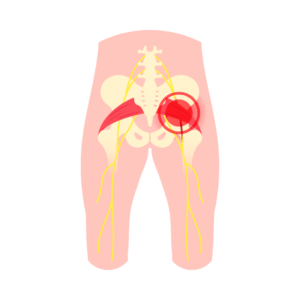PIRIFORMIS SYNDROME:
What Is It & How Can Sports Massage Help?
Piriformis Syndrome is a condition we have seen quite a bit in the clinic recently, so Cesar is here to help you understand what it is and how sports massage can help you in recovery!
Today, we are going to visit a condition known as piriformis syndrome. I will briefly describe clinically relevant anatomy, etiology (causes), some characteristics, investigations, examination, and overall management. The piriformis muscle originates from the top of the pelvis of sacral segments S2-S4, the sacroiliac joint, passing through the greater trochanter of the femur bone. The function of the piriformis muscle involves external rotation and abduction of the hip.

Piriformis syndrome is a painful musculoskeletal condition characterized by buttock or hip pain symptoms. In several articles, piriformis syndrome is defined as a peripheral neuritis where the branches of the sciatic nerve are responsible for the abnormal condition of the piriformis. According to the statistics, more women are diagnosed with piriformis syndrome than men, with a female–to–male ratio of 6:1. Piriformis syndrome is most commonly diagnosed in middle-aged patients.
The cause of this condition includes anatomical imbalances, muscles, spasms, prolonged sitting, overuse, or trauma. The signs and symptoms include local gluteal pain, difficulty walking, paresthesia (sensation of prickling or tingling similar to pins and needles), tingling sensations which may radiate down the buttock and leg, and pain is worse sitting. The pain exacerbates with any activity that causes hip flexion, including lifting, prolonged sitting, or walking. The diagnosis for this condition could be made by a physical examination that attempts to stretch the irritated piriformis and provoke the pain by doing a FABER test (flexion, abduction, external rotation). If you are experiencing any of these symptoms, piriformis syndrome could be the cause.
How does sports massage treat piriformis syndrome? A sports massage therapist can treat piriformis muscle spasms by introducing myofascial release, sports massage, trigger point therapy, soft tissue mobilization, hip joint mobilization, or hip strengthening to reduce strain on the piriformis. Our sports therapist can offer you long-term treatments, rehab advice and give you flexibility exercises to relieve piriformis spasms.

Piriformis syndrome is a painful condition affecting many aspects of your everyday life. People with piriformis syndrome find simple activities like walking, sitting, running, or squatting (especially for long periods) more challenging to perform than usual. An appointment with an experienced sports therapist is crucial for identifying piriformis muscle pain and ruling out other conditions in the lower body.
Contact us today to book your appointment with one of our expert sports massage therapists so we can help you get out of pain and back to living the life you love.


